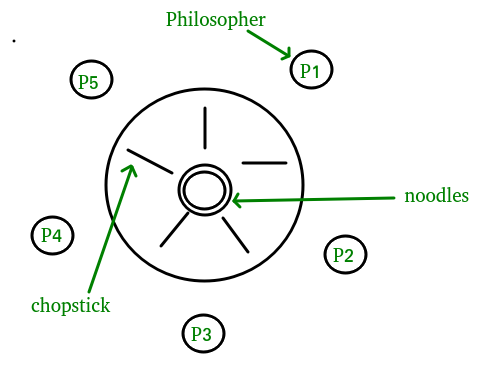Dining Philosophers Problem Solution Using Monitors in Java
Prerequisite: Monitor, Process Synchronization
Dining-Philosophers Problem – N philosophers seated around a circular table
Attention reader! Don't stop learning now. Practice GATE exam well before the actual exam with the subject-wise and overall quizzes available in GATE Test Series Course.
Learn all GATE CS concepts with Free Live Classes on our youtube channel.

- There is one chopstick between each philosopher
- A philosopher must pick up its two nearest chopsticks in order to eat
- A philosopher must pick up first one chopstick, then the second one, not both at once
We need an algorithm for allocating these limited resources(chopsticks) among several processes(philosophers) such that solution is free from deadlock and free from starvation.
There exist some algorithm to solve Dining – Philosopher Problem, but they may have deadlock situation. Also, a deadlock-free solution is not necessarily starvation-free. Semaphores can result in deadlock due to programming errors. Monitors alone are not sufficiency to solve this, we need monitors with condition variables
Monitor-based Solution to Dining Philosophers
We illustrate monitor concepts by presenting a deadlock-free solution to the dining-philosophers problem. Monitor is used to control access to state variables and condition variables. It only tells when to enter and exit the segment. This solution imposes the restriction that a philosopher may pick up her chopsticks only if both of them are available.
To code this solution, we need to distinguish among three states in which we may find a philosopher. For this purpose, we introduce the following data structure:
THINKING – When philosopher doesn't want to gain access to either fork.
HUNGRY – When philosopher wants to enter the critical section.
EATING – When philosopher has got both the forks, i.e., he has entered the section.
Philosopher i can set the variable state[i] = EATING only if her two neighbors are not eating
(state[(i+4) % 5] != EATING) and (state[(i+1) % 5] != EATING).
monitor DP
{
status state[5];
condition self[5];
Pickup( int i)
{
state[i] = hungry;
test(i);
if (state[i] != eating)
self[i].wait;
}
Putdown( int i)
{
state[i] = thinking;
test((i + 1) % 5);
test((i + 4) % 5);
}
test( int i)
{
if (state[(i + 1) % 5] != eating
&& state[(i + 4) % 5] != eating
&& state[i] == hungry) {
state[i] = eating;
self[i]. signal ();
}
}
init()
{
for
i = 0 to 4
state[i] = thinking;
}
}
Above Program is a monitor solution to the dining-philosopher problem.
We also need to declare
condition self[5];
This allows philosopher i to delay herself when she is hungry but is unable to obtain the chopsticks she needs. We are now in a position to describe our solution to the dining-philosophers problem. The distribution of the chopsticks is controlled by the monitor Dining Philosophers. Each philosopher, before starting to eat, must invoke the operation pickup(). This act may result in the suspension of the philosopher process. After the successful completion of the operation, the philosopher may eat. Following this, the philosopher invokes the putdown() operation. Thus, philosopher i must invoke the operations pickup() and putdown() in the following sequence:
DiningPhilosophers.pickup(i); ... eat ... DiningPhilosophers.putdown(i);
It is easy to show that this solution ensures that no two neighbors are eating simultaneously and that no deadlocks will occur. We note, however, that it is possible for a philosopher to starve to death.
This article is contributed by Mayank Rana. If you like GeeksforGeeks and would like to contribute, you can also write an article using contribute.geeksforgeeks.org or mail your article to contribute@geeksforgeeks.org. See your article appearing on the GeeksforGeeks main page and help other Geeks.
Please write comments if you find anything incorrect, or you want to share more information about the topic discussed above.
Dining Philosophers Problem Solution Using Monitors in Java
Source: https://www.geeksforgeeks.org/dining-philosophers-solution-using-monitors/
0 Response to "Dining Philosophers Problem Solution Using Monitors in Java"
Post a Comment